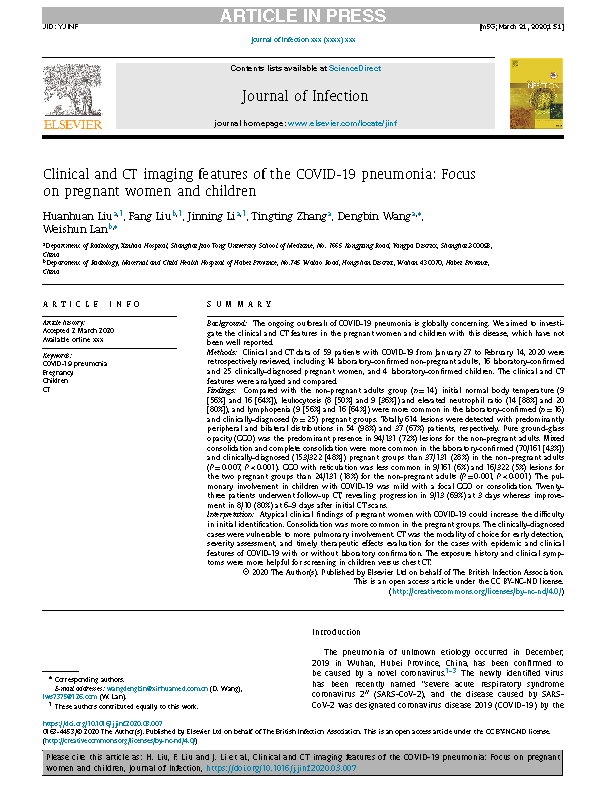Apr 01 Clinical and CT imaging features of the COVID-19 pneumonia: Focus on pregnant women and children
Huanhuan Liu, Fang Liu, Jinning Li, Tingting Zhang, Dengbin Wang, Weishun Lan

ABSTRACT
Background: The expanding outbreak of COVID-19 pneumonia is worrying globally. Our objective was to investigate the clinical and CT characteristics in pregnant women and children with this disease, which have not been previously well reported.
Methods: The clinical and CT data of 59 patients with COVID-19 were retrospectively reviewed from January 27 to February 14, 2020, including 14 laboratory-confirmed non-pregnant adults, 16 laboratory-confirmed pregnant women, and 25 clinically diagnosed pregnant women, and 4 laboratory confirmed children.
Clinical and CT characteristics were analyzed and compared.
Results: Compared with the non-pregnant adult group (n = 14), normal baseline body temperature (9 [56%] and 16 [64%]), leukocytosis (8 [50%] and 9 [36%]), and elevated neutrophils (14 [88%] and 20 [80%]) and lymphopenia (9 [56%] and 16 [64%]) were more frequent in laboratory diagnosis (n = 16) and clinical diagnosis ( n = 25) in the pregnant groups.
A total of 614 lesions with predominantly peripheral and bilateral distributions were detected in 54 (98%) and 37 (67%) patients, respectively:
- Ground glass opacity (GGO) was the predominant presence in 94/131 (72%) of the lesions in non-pregnant adults.
- Mixed union and complete union were more common in the laboratory-confirmed (70/161 [43%]) and clinically diagnosed (153/322 [48%]) pregnant groups than in 37/131 (28%) in the non-pregnant (P = 0·007, P <0·001).
- GGO with cross-linking was less common in lesions 9/161 (6%) and 16/322 (5%) for the two groups of pregnant women than 24/131 (18%) for non-pregnant adults (P = 0 · 001, P < 0·001).
- Pulmonary involvement in children with COVID-19 was mild with a focal GGO or consolidation.
Twenty-three patients underwent follow-up CT, revealing progression in 9/13 (69%) at 3 days, while improvement occurred in 8/10 (80%) at 6-9 days after the scans. initial computerized
Interpretation: Atypical clinical findings in pregnant women with COVID-19 could increase the difficulty in initial identification. Consolidation was more common in the pregnant groups. Clinically diagnosed cases are more vulnerable to greater pulmonary involvement. CT was the modality of choice for early detection, assessment of severity, and assessment of therapeutic effects for cases with epidemic and clinical features of COVID-19 with or without laboratory confirmation.
Exposure history and clinical symptoms were more useful for screening in children compared to chest CT.


